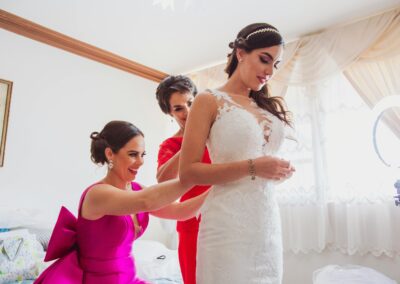Is $1500 Too Much for a Wedding Dress?
When you’re planning a wedding, deciding how much to spend on a dress can be a challenging task. You might wonder if you should stick to the typical 10% of the total budget or let your heart lead you to a pricier gown. It’s essential to balance dreams with practicality, reflecting on the variety of options from budget-friendly to high-end. But what about those hidden costs, like alterations or accessories, that can quickly add up? There’s more to reflect on than just the price tag and understanding these factors can guide you towards making a wise investment.

Understanding Wedding Dress Costs
When you’re stepping into the world of wedding dress shopping, understanding the factors that drive costs is essential. Wedding dress history and cultural influences play a significant role in pricing. Historically, wedding dresses evolved from simple garments to elaborate creations, often reflecting cultural values and status. Today, the average dress ranges from $1,500 to $2,500 in the U.S., with regional variations. Cities on the coasts see higher prices, driven by demand and designer availability. Designers and fabrics are key influencers; opting for luxurious materials like silk can elevate costs, while polyester offers affordability. Recognizing these elements helps you navigate the market trends and make informed choices, aligning your dream dress with both your budget and cultural expression. Additionally, some dresses can be found for $100 or less, typically before alterations, offering a more budget-friendly option for brides seeking affordability.
Factors Affecting Dress Price
As you familiarize yourself with wedding dress costs, it’s important to recognize the specific factors that influence pricing. Fabric sourcing plays a critical role; luxurious textiles like silk and satin are pricier due to their superior feel and appearance. Higher thread count and hand-applied embellishments elevate costs, while synthetic fabrics offer budget-friendly options. Design craftsmanship profoundly impacts price too. Couture and made-to-order dresses require expert tailoring and intricate handwork, driving up expenses. Elaborate designs with multiple layers or custom elements demand more time and expertise, increasing costs. Accessories, alterations, and designer prestige further affect the final price. Dresses from reputable designers using premium materials or from new collections will often have higher price tags, reflecting exclusivity and quality. The emotional significance attached to wedding dresses also contributes to their perceived value and influences how much people are willing to spend on them.
How to Set a Dress Budget
Setting a wedding dress budget might seem overwhelming, but it doesn’t have to be. Start by allocating about 10% of your total wedding budget to your dress, including necessary alterations and accessories. This dress budget strategy guarantees you’re financially prepared for the $1,900 to $2,000 average cost, plus alterations and accessories, which can add up to $800. Prioritize spending by deciding if the dress is a top priority, potentially adjusting other budget areas. Research specific costs for alterations and accessories to avoid surprises. Communicate your budget clearly with consultants to prevent overspending. By setting a firm budget, you’ll focus on essentials and navigate trends wisely, embracing priority spending tips that keep your finances in check. Exploring simpler designs can help reduce costs, making it easier to accommodate alterations without exceeding your budget.
Finding Affordable Dress Options
You’ve set your budget and now it’s time to explore where style meets savings with affordable wedding dress options. Look into alternative designers like Anthropologie or Park & Fifth, offering chic options without breaking the bank. For those seeking quick and budget-friendly choices, Lulus provides dresses from as low as $79. Bridal outlets such as Kleinfeld Bridal showcase affordable elegance under $2,000, featuring renowned designers like Maggie Sottero. Dresses priced below $2,000 are considered affordable, allowing you to allocate more of your budget to other wedding-related expenses. To maximize your budget, consider opting for simple fabrics and minimizing embellishments, which can slash costs. Shopping early and exploring previous season or sample sale dresses can also lead to significant savings. Whether you’re seeking luxury with Yedyna or a trendy bargain, these strategies guarantee your dream dress fits both your style and budget.
Who Pays for the Dress
While tradition often dictates that the bride’s family covers the cost of the wedding dress, modern trends show a shift towards more flexible payment arrangements. Today, approximately half of brides choose to pay for their own wedding attire, reflecting a move away from historical customs. Payment trends indicate that about 10% of brides handle the entire expense themselves, while others split costs with family or partners. In urban areas, it’s increasingly common for couples to share the financial responsibility. Setting a budget beforehand is essential, especially if multiple parties are involved, to avoid overspending and misunderstandings. As cultural norms evolve, discussions around who pays for the dress are becoming more collaborative, reflecting the joint decision-making seen in modern relationships. Since custom gowns are generally more expensive than off-the-rack options, many brides consider these financial arrangements carefully.
Market Trends and Insights
Even though wedding dresses are a significant expense, understanding the current market trends can help you make a smart decision. In 2025, the average cost of a wedding dress ranges from $1,500 to $2,500, influenced by factors like design complexity, fabric choice, and designer reputation. Seasonal trends and popular wedding dress styles can also impact prices, with high-end options reaching $10,000. However, budget-friendly brides can find off-the-rack or sample sale dresses for under $1,000. Keep in mind, alterations may add $200 to $600. Open communication about finances is recommended for clarity, as many brides opt to purchase their own dresses. To stay on trend, consider how seasonal influences can affect both style and price. Smart planning and awareness of these trends can guarantee you find the perfect dress within your budget.
Evaluating Brand and Design Choices
Steering through the world of wedding dress shopping can be overwhelming, given the diverse array of brands and design choices available. High-end labels like Zuhair Murad, known for their meticulous craftsmanship, start at $10,000, emphasizing brand reputation and luxury. If you’re seeking design innovation without breaking the bank, consider mid-range options like Maggie Sottero, blending traditional and contemporary styles between $1,500 and $5,000. For budget-conscious brides, Rosa Clará offers affordable elegance. Vera Wang presents a mix of luxury and affordability, renowned for trendsetting designs starting at $1,900. Customization is key with brands like BelleAmore, allowing tailored budgets and personalized styles. BelleAmore, based in China, offers a diverse selection of bridal gowns, featuring versatile styles and high-quality fabrics, making it a compelling choice for brides seeking both quality and customization. Whether you prefer timeless elegance or avant-garde flair, there’s a brand to fit your vision and budget.



